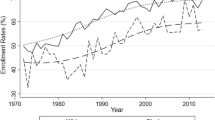Abstract
By most statistical indicators, the educational gains made by black women during the past decade are rapidly being eroded: high school completion rates and college enrollment figures are declining, and dropout rates are increasing. The increase in black women earning bachelors and graduate degrees is due almost entirely to their higher participation rates in college. A higher proportion of blacks than whites are below 24 years of age; declining enrollments at a time when the black population is expanding reflects a significant loss. Important areas for policy initiatives include increases in financial aid. a critical factor in college attendance by black women-particularly at the graduate and professional degree levels-improvement in quality of primary and secondary education and counseling, and continuing education programs for teenage mothers.
Similar content being viewed by others
Notes
Carnegie Foundation for the Advancement of Teaching, “‘Sustaining the Vision’: Text of Statement by Carnegie Foundation,” reprinted inChronicle of Higher Education 30, no. 14, June 5, 1985, p. 18.
America’s Black Population, 1970-1982, Bureau of Census, 1983, p. 16.
Carnegie Foundation for the Advancement of Teaching, p. 18.
Taken from Table 59: Percent of High School Dropouts Among Persons 14 to 34 Years Old, by Age, Race and Sex: United States, October 1971 and October 1981, published in W. Vance Grant and Thomas D. Snyder,Digest of Education Statistics,1983-1984, p. 71.
Taken from Table 9: Percentage of 1980 Sophomores Who Dropped Out Before Graduation by Sex and Selected Background Variable, published in Samuel S. Peng, Ricky T. Takai. and William B. Fetters, “High School Dropouts,” reprinted in Office of Minority Concerns,Minorities in Higher Education, American Council on Education. 1984, p. 11.
Ibid., p. 11.
Taken from Table 658: Civilian Labor Force-Employment Status, By Sex, Race and Age: 1983, inStatistical Abstract of the United States: 1985, p. 394 (U.S. Bureau of Labor Statistics,Employment and Earnings, published monthly).
Taken from figures compiled by the population division of the U.S. Census Bureau cited in Gaynelle Evans, “Social, Financial Barriers Blamed for Curbing Blacks’ Access to College,”Chronicle of Higher Education, August 7, 1985.
Linda Darling-Hammond,Equality and Excellence: The Educational Status of Black Americans, College Board Publications, 1985, cited inChronicle of Higher Education, April 17, 1985, p. 1.
Office of Minority Concerns, pp. 7–8.
National Center for Education Statistics,Fall Enrollment in Higher Education, U.S. Department of Education, 1978, 1980, 1982.
Office of Minority Concerns, Table 2: General Population Characteristics by Age Group, Race and Ethnicity, 1980, p. 7.
Office of Minority Concerns, Table 20: Change in Degrees Awarded to Blacks by Level of Degree and Sex, 1976-1981, from Susan T. Hill, “Participation of Black Students in Higher Education: A Statistical Profile from 1970-71 to 1980-81,” Washington, D.C.: U.S. Department of Education, National Center for Education Statistics, 1983, published in Office of Minority Concerns,Op. Cit., p. 15 and p. 17.
Joseph Katz, “White Faculty Struggling with the Effects of Racism,” in J.H. Cones, J.E Noonan, and D. Janha (Eds.),Teaching Minority Students, New Directions for Teaching and Learning, no. 16, San Francisco: Jossey-Bass, December 1983, p. 33.
Gloria Scott, Unpublished study of black women administrators in higher education, Clark College, Atlanta, Georgia, 1984. Statistics also verified by Office of Women, American Council on Education, 1985.
Black Women’s Action Plan, National Women’s Conference, Houston, 1977.
Unpublished proceedings from Conference on Black Women and the Economy, Wingspread Conference Center, Racine, Wisconsin, 1984.
Jewelle Taylor Gibbs, “Black Adolescents and Youth: An Endangered Species,”American Journal of Orthopsychiatry 54, no. 1, January 1984.
About this article
Cite this article
Wilkerson, M.B. A report on the educational status of black women during the un decade of women, 1976–85. The Review of Black Political Economy 14, 83–96 (1985). https://doi.org/10.1007/BF02689877
Issue Date:
DOI: https://doi.org/10.1007/BF02689877




